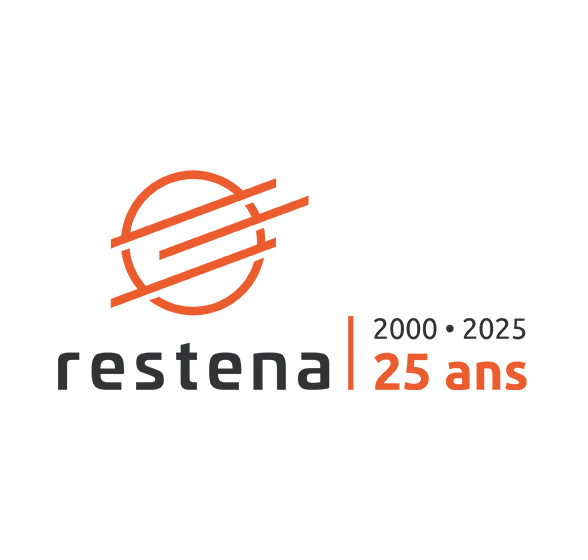On 19 June 2000, 25 years ago, a deed was signed. From the RESTENA project emerged the Restena Foundation, then approved by the Grand-Ducal Decree of 27 July 2000. Théo Duhautpas et Antoine Barthel are the first directors. They will perform their duties until 2015 and 2017 respectively before handing over to Gilles Massen, still leading Restena in 2025. When the Restena Foundation was created, the current Director of Restena was already one of the first 8 employees. With him, Restena sets out its ambitions for 2025 to 2030.
The RESTENA network, cradle and engine
The RESTENA network infrastructure has always been and continues to be Restena’s core business. In the future, it will be just as essential and central to its activities, keeping pace with technical, social and political developments. It is not only the foundation on which Restena’s range of services is built (email, hosting, .lu, computer security and network), but also the critical component in the communication need of the research and education community. In this context, the infrastructure will support the government strategies for speeding up the numerical sovereignty - as from 2030 - about data, artificial intelligence (AI) and quantum technologies. It will therefore have to evolve towards even more speed, resilience and flexibility, while providing the best possible service to the ever-increasing expectations of partners, governmental authorities, and final users. To achieve this, maintaining technical skills within Restena and presence on the international scene with international homologues are crucial.
‘AI, with its requirements, limitations and potential promises is in any case closely watched by Restena.’
To support AI activities, Restena’s fundamental role will be a core infrastructure enabling the enormous data transfers that are essential for AI training and use. The foundation is already involved in research projects related to quantum communication, in particular the European project “Luxembourg Experimental Network for Quantum Communication Infrastructure” (LUX4QCI) that intends to deliver the first experimental Quantum Communication Infrastructure (QCI) network in Luxembourg. Two other projects within the same technology theme have been submitted during the first quarter of 2025. Whatever the outcome of these calls for projects will be, Restena will ensure that the RESTENA network remains a tool for research beyond the data transporter.
'A current initiative is the implementation of a European time and frequency network that will make available new instruments for researchers and the national metrological institute and therefore create new use cases through a novel use of the RESTENA infrastructure.’
This horizontal infrastructure role is likely to be expanded to meet needs emerging from the research and education community. At this stage, it is essential to monitor current and upcoming requirements – although uncertainties are clouding the future.
From security to potential control
The security environment and geopolitical events that are shaping today's world are a real challenge, both for Restena and the other European and worldwide National Research and Education Networks (NRENs). Security services and the overall approach towards security and the community’s interests will undeniably be affected and will require additional added value that can only be achieved through ever more advanced collaboration.
The context of the top-level domain names is a prime example for external pressure. Management and operation of the national registry for the .lu top-level domain name and its related critical infrastructure is to be moving towards more legal constraints. They will impact Restena as well as the other top-level domain name registries across Europe, and their evolution needs to be monitored very closely. Restena is at the crossroads of the constraints imposed by regulations and demands driven by ongoing efforts to use the domain names as a control tool, despite the risk of collateral damage.
‘As of now, it is impossible to predict what the domain name landscape will look like in the next few years. How will fundamental rights, due process and security requirement be combined, without sacrificing one for the other?’
In this field, evolving since the creation of domain names, Restena constantly reassesses its role in the treatment of sub domains abuse, while trying to preserve the balance between control, freedom of expression and protection of victims.
The scope of the tasks ahead will require to review the necessary resources. This development must however not lose sight of Restena’s DNA: working for efficient services and bringing unique added value to the research and education community.
Flashback to 2000-2025
Over the years the Restena Foundation’s team has almost tripled, while its activities followed closely the technical, societal and political evolutions. Gilles Massen has been present at every stage of Restena's development. Below is a look back at some of the key elements in Restena's history that have left their mark on the current director.
- The growing collaboration with LU-CIX has led Restena to manage most of the national internet exchange backbone LU-CIX, and to jointly operate the national centre for volumetric Distributed Denial of Service (DDoS) at the service of the High Commission for National Protection.
- Adoption of the ISO27001 standard and its impact on the way of working at Restena, increasing formalisation and maturity of operations and procedures.
- The COVID-19 pandemic introduced and perpetuated home office.
- The growing importance of IT security issues over the years both internally and in the services offered.
- Growth in the Restena workforce which, despite changing working methods, has never undermined the cooperation and motivation of everyone to work for the Restena missions.
On a personal level, the participation of Gilles Massen as Director of Restena in decision-making bodies from the two European association GÉANT and CENTR confirmed the importance of Restena and has given the foundation access to large-scale projects. His presence at the heart of the governance in the two organisations uniting all of Restena’s homologues – in research networking and .lu domain names management - have made it possible to see beyond simple collaboration and provide Restena increased visibility on a European and national stage.

